Digital Poster
fMRI Acquisition & Analysis I
ISMRM & ISMRT Annual Meeting & Exhibition • 03-08 June 2023 • Toronto, ON, Canada

| Computer # | |||
|---|---|---|---|
2529.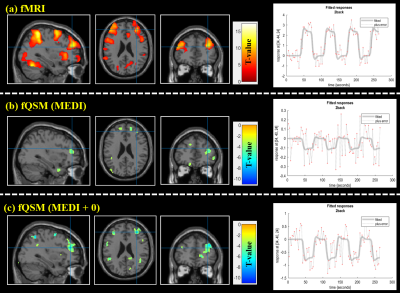 |
1 |
Cerebrospinal fluid as a zero reference regularization for
functional quantitative susceptibility mapping
Chang-Jin Huang1,
Hong-Yi Wu1,
Changwei Wu2,
Shen-Mou Hsu3,
and Jyh-Hong Chen4
1Graduate Institute of Biomedical Electronics and Bioinformatics, National Taiwan University, Taipei, Taiwan, 2Research Center for Brain and Consciousness, Taipei Medical University, Taipei, Taiwan, 3Imaging Center for Integrated Body, Mind and Culture Research, National Taiwan University, Taipei, Taiwan, 4Department of Electrical Engineering, National Taiwan University, Taipei, Taiwan Keywords: Data Analysis, Quantitative Susceptibility mapping Functional quantitative susceptibility mapping (fQSM) providing complementary quantitative information for fMRI, has been applied to study brain functions. However, the sensitivity of fQSM suffers from the QSM reconstruction, especially solving an ill-posed deconvolution. To improve the sensitivity of fQSM, we first applied MEDI+0 in fQSM study. This method using cerebrospinal fluid as a zero reference regularization has been proven to reduce the variability of the susceptibility maps from rescan. The higher common voxel ratio and cosine similarity scores were obtained by MEDI+0 than by MEDI. Activated voxels were successfully detected by MEDI+0 during high cognition task from standard fMRI acquisition. |
|
2530.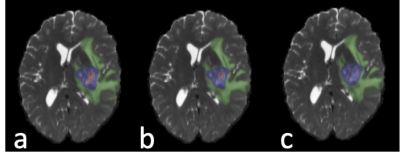 |
2 |
Tumor Tissue Segmentation for Seed-based Mapping of Peritumoral
Resting-State Connectivity in Patients with Glioblastomas
Kevin Marcus Rosenberg1,2,3 and
Stefan Posse3,4,5
1Lovelace Medical System, Albuquerque, NM, United States, 2University of New Mexico, Albuquerque, NM, United States, 3Neurinsight LLC, Albuquerque, NM, United States, 4Neurology, University of New Mexico, Albuquerque, NM, United States, 5Physics and Astronomy, University of New Mexico, Albuquerque, NM, United States Keywords: Machine Learning/Artificial Intelligence, fMRI (resting state) In this study, we developed a model-free seed selection approach using deep learning-based tumor tissue segmentation in combination with iterative subject-specific seed-optimization which improves the specificity of peri-tumoral seed selection. The methodology automates seed placement in the vicinity of the tumor in the zone that is at risk during surgical resection without relying on neurofunctional brain atlases. Evaluation of cortical eloquence in different tumor subregions, such as edematous and infiltrative regions was feasible using a single MRI contrast. This computationally efficient approach was integrated into a real-time resting-state fMRI analysis pipeline to characterize peri-tumoral connectivity in patients with glioblastomas. |
|
2531.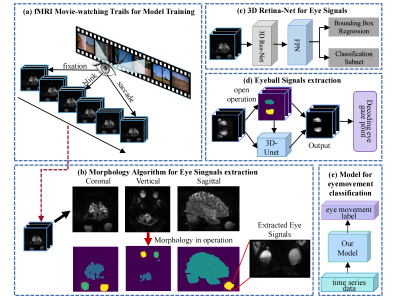 |
3 |
MRGazerII: Camera-free Decoding Eye Movements from Functional
Magnetic Resonance Imaging
Rongjie Hu1,
Jie Liang1,
Yiwen Ding2,
Shuang Jian2,
Xiuwen Wu1,
Yanming Wang1,
Yong Zhang3,
Zhen Liang2,
Bensheng Qiu1,
and Xiaoxiao Wang1
1Center for Biomedical Imaging, University of Science and Technology of China, Hefei, China, 2Anhui Medical University, Hefei, China, 3GE Healthcare, Shanghai, China Keywords: Machine Learning/Artificial Intelligence, fMRI, eye movement Eye movements reflect changes in human behavior and thought to some extent, but many functional magnetic resonance imaging (fMRI) studies are limited by equipment and do not perform eye movement tracking. Recently, a deep learning method has been proposed for the regression problem of a single volume's gaze point. In this paper, we propose an end-to-end pipeline called MRGazerⅡ, which includes eye signal extraction, eye-movement behavior recognition and gaze point regression from fMRI scanning slices. The method was tested on the human connectome project (HCP) fMRI dataset and achieved the desired performance. |
|
2532.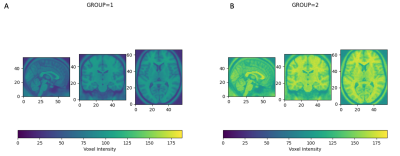 |
4 |
Harmonization of Multi-Site rs-fMRI data using CovBat
Katherine Breedlove1,2,
Hector Arciniega1,2,
Sylvain Bouix3,
Martha Shenton1,2,
and Alexander Lin1,2
1Brigham and Women's Hospital, Boston, MA, United States, 2Harvard Medical School, Boston, MA, United States, 3University of Quebec, Montreal, QC, Canada Keywords: Software Tools, fMRI (resting state) Multisite studies are an important feature of modern neuroimaging research as they allow the study of larger and more diverse populations, which is essential to obtain clinically relevant insight and sensitivity to subtle effects. However, due to the variability among scanner platforms, even when utilizing the same acquisition protocols, harmonization is needed to remove site-to-site variability in order to improve signal-to-noise ratio and improve statistical power. By implementing CovBat as a BIDS application, we have created a turnkey application that quickly minimizes confounding signals in multisite fMRI studies. |
|
2533.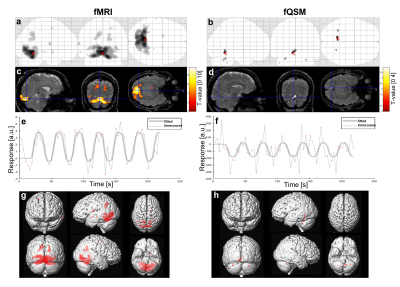 |
5 |
Preliminary Functional Quantitative Susceptibility Mapping with
Multi-Echo EPI
Jannette Nassar1,
Oliver C. Kiersnowski1,
Patrick Fuchs1,
and Karin Shmueli1
1Medical Physics and Biomedical Engineering, University College London, London, United Kingdom Keywords: Data Analysis, Brain, Quantitative Susceptiblity Mapping, fQSM, fMRI Functional QSM (fQSM) detects changes in blood oxygenation in response to neuronal activation, providing complementary information to conventional magnitude-based fMRI. For standard structural gradient-echo QSM, multi-echo (ME) acquisitions are more accurate than single-echoes. Preliminary work suggests this holds for ME-EPI. Previous fQSM studies used single-echo EPI with physiological noise correction but with ME-EPI, we observed fQSM activations in the visual cortex with a visual stimulus without physiological noise correction. ME and single-echo EPI fQSM were compared, showing that ME-EPI might be preferable. fQSM activations were weaker (maximum T-score=4 compared to 10 in fMRI) and more localised than fMRI, as expected. |
|
2534. |
6 |
Spatial-temporal reconstruction using UNFOLD in looping-star
silent fMRI
Haowei Xiang1,
Jeffrey A. Fessler1,
and Douglas C. Noll2
1EECS, University of Michigan, Ann Arbor, MI, United States, 2Biomedical Engineering, University of Michigan, Ann Arbor, MI, United States Keywords: Image Reconstruction, Brain Looping star is a silent MRI pulse sequence that can be used for quantitative susceptibility mapping (QSM), T2*-weighted imaging and fMRI. However, the sparse radial sampling of looping-star limits its spatial and temporal resolution in fMRI studies. This work proposes a customized looping-star fMRI protocol and a spatial temporal reconstruction method that removes the undersampling artifact from the repeating sampling pattern and improves the temporal resolution and quality of the time course and activation map. |
|
2535.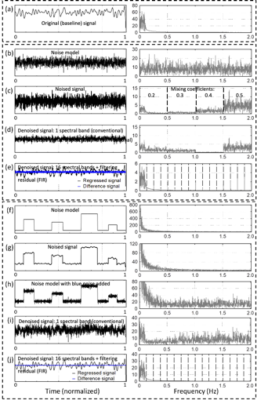 |
7 |
High-Frequency Resting-State Connectivity using Spectrally
Segmented Regression of Movement, Physiological Noise and
Spectral Residuals
Khaled Talaat1,
Bruno Sa De La Rocque Guimaraes2,
and Stefan Posse3,4
1Nuclear Engineering, University of New Mexico, Albuquerque, NM, United States, 2Nucelar Engineering, University of New Mexico, Albuquerque, NM, United States, 3Neurology, University of New Mexico, Albuquerque, NM, United States, 4Physics and Astronomy, University of New Mexico, Albuquerque, NM, United States Keywords: Data Processing, fMRI (resting state) Regression of filtering residuals is introduced to spectrally segmented regression of nuisance parameters in high-speed fMRI to enable the application of finite impulse response filters for spectral segmentation of regressors. This extension of our previously introduced method of spectrally and temporally segmented regression improves the removal of noise and mitigates the introduction of artefactual correlations in high frequency resting-state fMRI. Simulations and in-vivo data demonstrate significant advantages of spectrally segmented regression compared to whole-band regression when frequency-dependent errors are present in the regression model. High-frequency resting-state connectivity is detected with high sensitivity during normo-, hypo- and hypercapnic state. |
|
2536.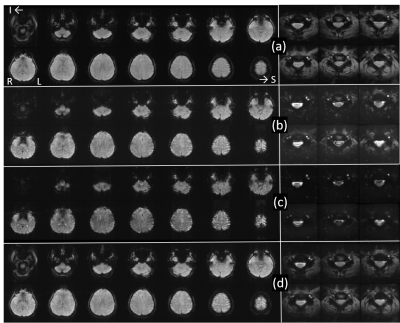 |
8 |
Improved BOLD activation using multiecho acquisition in
simultaneous brain-spinal cord fMRI
Christine Sze Wan Law1,
Ken Weber1,
Merve Kaptan1,
Dario Pfyffer1,
Sean Mackey1,
and Gary Glover1
1Stanford University, Stanford, CA, United States Keywords: Data Processing, Spinal Cord, fmri, multiecho, brain Functional activation within brain has been studied extensively using fMRI. But limiting investigation to only the brain provides a truncated view of the human central nervous system as it does not capture information exchange between brain and body periphery through spinal cord. Simultaneous brain-spinal cord fMRI provides a means to measure motor and pain activity across the central nervous system. BOLD signal, especially in spinal cord, usually suffers from poor signal-to-noise ratio (SNR) which can cause difficulty in detecting activation. Here, we demonstrate that multiecho acquisition improves spinal cord BOLD detection. |
|
2537.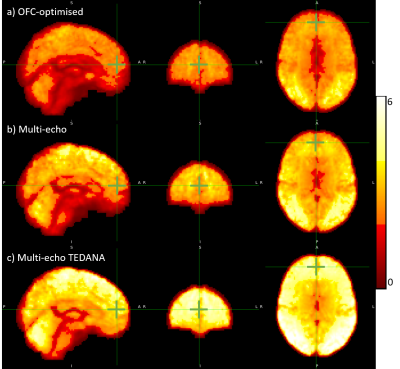 |
9 |
Multi-echo EPI more effectively boosts BOLD sensitivity than
sequence optimization in orbitofrontal cortex
Vahid Malekian1,
Nadège Corbin1,2,
Michael Moutoussis1,3,
and Martina F. Callaghan1
1Wellcome Centre for Human Neuroimaging, UCL Queen Square Institute of Neurology, University College London, London, United Kingdom, 2Centre de Résonance Magnétique des Systèmes Biologiques, CNRS‐University Bordeaux, Bordeaux, France, 3Max Planck University College London Centre for Computational Psychiatry and Ageing Research, London, United Kingdom Keywords: Data Acquisition, fMRI Multi-echo fMRI can boost BOLD sensitivity relative to conventional single-echo fMRI, especially in high-susceptibility brain regions like orbito-frontal cortex (OFC). Another option is to optimise slice-tilts, z-shimming and k-space traversal to minimise susceptibility effects. In this study, we sought to determine if multi-echo EPI, which requires the use of parallel imaging to achieve reasonable echo times, would remain optimal in OFC when compared to an OFC-optimised single echo alternative. The relative performance is quantified via BOLD contrast-to-noise ratio and an additional comparison is made by incorporating the TE Dependent ANAlysis (TEDANA) denoising approach. Multi-echo increased BOLD CNR, particularly following denoising. |
|
2538.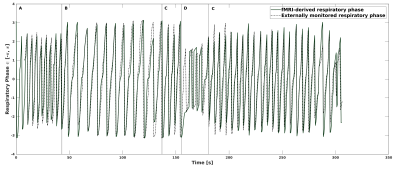 |
10 |
Synthesis of Respiratory Phase from Image Phase in Resting-State
Functional Magnetic Resonance Imaging
Alexander Jaffray1,
Michelle Medina1,
Christian Kames1,
and Alexander Rauscher1,2
1Physics, UBC MRI Research Centre, Vancouver, BC, Canada, 2Department of Pediatrics, UBC, Vancouver, BC, Canada Keywords: Data Processing, fMRI (resting state), Breathing Belt, Respiratory Phase Functional Magnetic Resonance Imaging (fMRI) is routinely acquired using gradient-echo sequences with long echo times and short repetition time. Such sequences encode information about the magnetic field in the often discarded image phase. We demonstrate a method for processing the phase of reconstructed fMRI data to isolate temporal fluctuations in the harmonic fields associated with respiration by solving a blind source separation problem. Computed respiratory phase from the fMRI-derived field fluctuations was shown to be in strong agreement with breathing belt data acquired during the same scan. This work thus presents a hardware free measurement of respiratory phase. |
|
2539.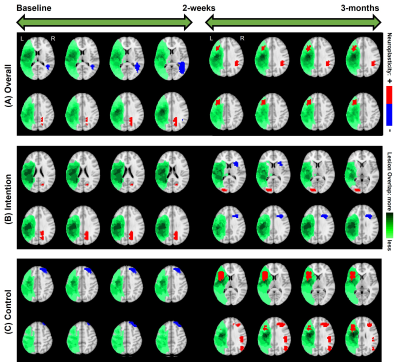 |
11 |
Bayesian Longitudinal Tensor Response Regression to model
task-fMRI based neuroplasticity in post-stroke aphasia
Venkatagiri Krishnamurthy1,2,
Alec Reinhardt3,4,
Serena Song2,
Joo Han2,
M. Lawson Meadows2,
Bruce Crosson2,
and Suprateek Kundu3,4
1Dept. of Medicine, Emory University, Atlanta, GA, United States, 2Atlanta VA Medical Center, Decatur, GA, United States, 3Dept. of Biostatistics, Emory University, Atlanta, GA, United States, 4Dept. of Biostatistics, UT MD Anderson Cancer Center, Houston, TX, United States Keywords: Data Analysis, fMRI (task based), Neuroplasticity Stroke is inherently complex due to the heterogeneity in lesion location, size in addition to other clinical comorbidities. Further, longitudinal three-dimensional fMRI datasets add more complexity towards estimating sensitive and robust biomarkers of neuroplasticity. In this study we propose an innovative extension of Bayesian Tensor Response Regression (BTRR) approach to estimate neuroplasticity that is more sensitive, accurate and reliable compared to traditional voxel-wise approach. Results from our longitudinal aphasia-treatment study not only show that the BTRR approach is more superior but is also able to derive plasticity estimates that are sensitive to treatment differences that are subject and time-point specific. |
|
2540. |
12 |
Comparison of test–retest reliability of structural, resting
state functional, and diffusion tensor magnetic resonance
imaging
Di Hu1,
Yanqiu Lv1,
Dandan Zheng2,
Geli Hu2,
Peng Sun2,
and Yun Peng1
1The Department of Radiology,, Beijing Children's Hospital, Capital Medical University, National Center for Children's Health, Beijing, China, 2Clinical & Technical Support, Philips Healthcare, Beijing, China Keywords: Data Analysis, Reproductive We measured imaging reproducibility in structural, resting state fMRI and diffusion tensor scans across different time points and scanners in healthy volunteers. First, we assessed structural imaging variability by calculating volume for seven subcortical structures. Second, we evaluated across-scanner and across-time reliability of rsfMRI by assessing temporal signal-to-noise ratio of five networks. Finally, we assessed variability in diffusion metrics across scanners and time points. Our results provide statistical validations for longitudinal work on multiple systems, especially for structural study. The influence of different equipment in rsfMRI and DTI related research may be considered, especially DMN and GCC analysis involved. |
|
2541.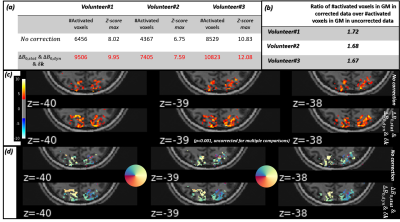 |
13 |
Impact of B0 field imperfections correction on BOLD sensitivity
in 3D-SPARKLING fMRI data
Zaineb Amor1,
Caroline Le Ster1,
Chaithya G.R.1,2,
Guillaume Daval-Frérot1,2,3,
Bertrand Thirion1,2,
Nicolas Boulant1,
Franck Mauconduit1,
Christian Mirkes4,
Philippe Ciuciu1,2,
and Alexandre Vignaud1
1Université Paris-Saclay, CEA, NeuroSpin, CNRS, Gif-sur-Yvette, France, 2Université Paris-Saclay, Inria, MIND, Palaiseau, France, 3Siemens Healthineers, Saint-Denis, France, 4Skope Magnetic Resonance Technologies AG, Zurich, Switzerland Keywords: Data Acquisition, fMRI Static and dynamic ∆B0 field imperfections are detrimental for fMRI applications as they degrade the temporal SNR (tSNR) and the sensitivity to the BOLD contrast. In this work we propose an experimental protocol for field imperfection monitoring and correction on 3D-SPARKLING fMRI data using the Skope Clip-on field camera in an alternative setting challenging its long TR constraint. We demonstrate the viability of our protocol and the reproducible gain in image quality, tSNR and retinotopic maps when correcting static and dynamic field imperfections on resting-state and task-based fMRI data for 3 healthy volunteers |
|
2542.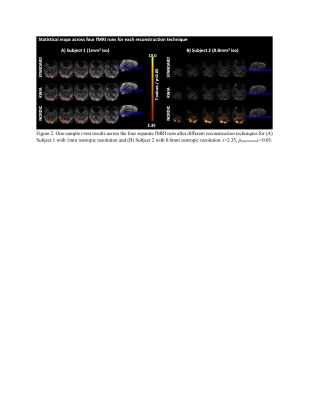 |
14 |
Noise Reduction for Task-Based Functional Magnetic Resonance
Imaging using NORDIC and KWIA
Ru Zhang1,
Zhifeng Chen2,
Chengyang Zhao1,
Danny J.J. Wang1,
and Kay Jann1
1Mark and Mary Stevens Neuroimaging and Informatics Institute, University of Southern California, Los Angeles, CA, United States, 2Monash Biomedical Imaging, Department of Data Science & AI, Faculty of IT, Monash University, Clayton, Australia Keywords: Image Reconstruction, Image Reconstruction We quantitatively evaluate the performance of NORDIC and KWIA methods in denoising of high-resolution task-fMRI data from 7T in comparison to the standard manufacturer reconstruction. We found that both techniques improve single run statistics as well as improved consistency across runs. Analysis of tSNR confirmed improved data quality in the time domain that facilitates time-series analysis for task-fMRI. |
|
2543.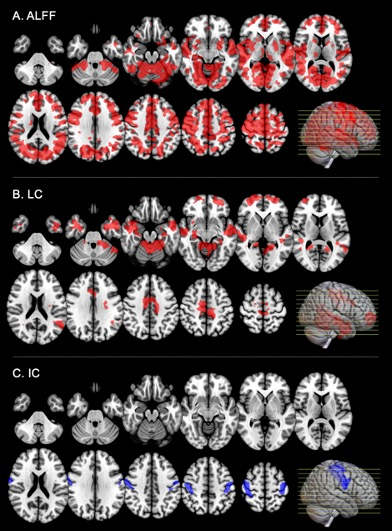 |
15 |
Increased BOLD resting-state fluctuation amplitude following
upregulation of inhibitory activity with the GABA agonist
alprazolam
Fanny Munsch1,
Manuel Taso1,
Daniel H. Wolf2,
Daniel Press1,
Stephanie Buss1,
John A. Detre2,
and David C. Alsop1
1Beth Israel Deaconess Medical Center, Harvard Medical School, Boston, MA, United States, 2University of Pennsylvania, Philadelphia, PA, United States Keywords: Data Analysis, fMRI (resting state), Pharmacological MRI | Drugs | GABA | Brain connectivity Neural activity reflects a complex interplay between excitatory and inhibitory signaling. Yet, the BOLD signal is typically interpreted as related to excitatory activity. However, GABAergic neurotransmission also requires metabolism and BOLD may be sensitive to this inhibitory activity that can promote coordinated activity across networks. Here, we evaluated the changes in BOLD rsfMRI and rsCBF metrics (amplitude of low frequency fluctuations (ALFF), intrinsic connectivity (IC) and local correlations (LC)) after oral administration of alprazolam, a GABA agonist, in healthy volunteers. We observed a highly significant increase of BOLD ALFF across the cortex that suggests increasing inhibition can increase BOLD signals. |
|
2544.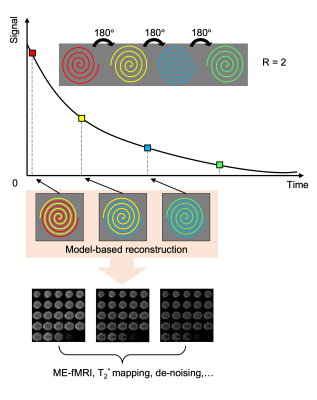 |
16 |
3D Multi-echo spiral acquisition with model-based reconstruction
for fMRI
Zidan Yu1,
Christoph Rettenmeier1,
and V. Andrew Stenger1
1Department of Medicine, University of Hawaii, Honolulu, HI, United States Keywords: Data Acquisition, fMRI Multi-echo fMRI is of current interest due to its potential for more accurate BOLD contrast with reduced artifacts. Furthermore, spiral trajectories are advantageous for fMRI because of high sampling efficiency. However, images are susceptible to blurring due to B0 inhomogeneity. In this study, we present a 3D multi-echo spiral sequence with a model-based reconstruction method that combines under sampled spiral data from different echoes for increased sampling efficiency and reduced B0 artifacts. Multi-echo and single-echo spiral fMRI data including T2* maps were acquired and compared at 3T demonstrating the method. |
|
2545.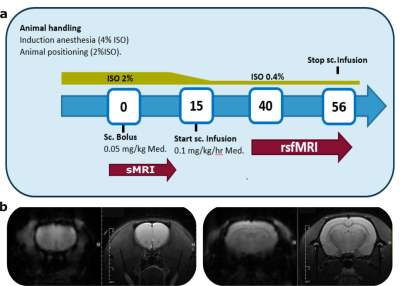 |
17 |
A consensus Protocol for task-free Anesthetized Rat functional
Magnetic Resonance Imaging and Data Analysis
Roël Matthijs Vrooman1,
Gabriel Desrosiers-Gregoire2,3,
Gabriel Devenyi2,4,
Yen-Yu Ian Shih5,6,7,
Sung-Ho Lee5,6,
Monica van den Berg8,9,
Georgios Keliris8,9,
and Joanes Grandjean1,10
1Donders Institute for Brain, Cognition and Behaviour, RadboudUMC, Utrecht, Netherlands, 2Cerebral Imaging Centre, Douglas Mental Health University Institute, Verdun, QC, Canada, 3Integrated Program in Neuroscience, McGill University, Montreal, QC, Canada, 4Department of Psychiatry, McGill University, Montreal, QC, Canada, 5Center for Animal MRI, The University of North Carolina at Chapel Hill, Chapel Hill, NC, United States, 6Neurology, The University of North Carolina at Chapel Hill, Chapel Hill, NC, United States, 7Biomedical Engineering, The University of North Carolina at Chapel Hill, Chapel Hill, NC, United States, 8Bio-imaging lab, University of Antwerp, Antwerpen, Belgium, 9µNEURO Research Centre of Excellence, University of Antwerp, Antwerpen, Belgium, 10Department for Medical Imaging, Radboud University Medical Center, Nijmegen, Netherlands Keywords: Data Acquisition, fMRI (resting state), Rat, Rodent fMRI in rats is performed under diverse protocols that span different animal handling practices and preprocessing steps. The disparity in image acquisition and preprocessing hampers the interoperability and comparison of the results between studies. Importantly, it is unclear what factors lead to superior acquisition and detection of functional networks. We detail a consensus-based task-free fMRI acquisition protocol in the rat that has been validated in 21 datasets. Along with the animal handling protocol and MRI sequence, we provide a detailed path for data conversion, preprocessing, and analysis. |
|
2546.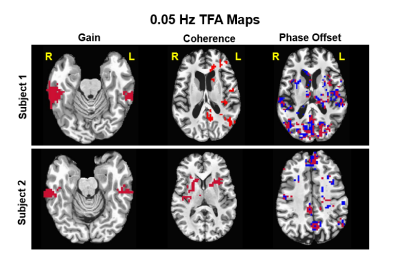 |
18 |
A Novel Approach to Estimate Whole-Brain Dynamic Cerebral
Autoregulation using Task-fMRI
Joo Han1,
Justin D. Sprick2,3,
Lisa C. Krishnamurthy1,4,
Serena Song1,
and Venkatagiri Krishnamurthy1,5
1Center for Visual and Neurocognitive Rehabilitation, Atlanta VAMC, Decatur, GA, United States, 2Division of Renal Medicine, Department of Medicine, Emory University, Atlanta, GA, United States, 3University of North Texas Health Science Center, Denton, TX, United States, 4Department of Physics & Astronomy, Georgia State University, Atlanta, GA, United States, 5Division of Geriatrics and Gerontology, Department of Medicine, Emory University, Atlanta, GA, United States Keywords: Signal Modeling, fMRI (task based) The limitation of estimating Dynamic Cerebral Autoregulation (dCA) using Transcranial Doppler ultrasound is the lack of whole-brain estimation capabilities. In this study, the data acquisition of whole-brain task-fMRI scan during a novel Passive Cyclical Leg Raise (PCLR) task allows us to induce blood pressure (BP) changes. A surrogate BP signal was acquired from the brain stem and depicts expected fluctuations based on the PCLR-task design. The whole-brain dCA was estimated using voxel-wise TFA to obtain the transfer gain, coherence, and phase-offset. These results show similar significant brain regions but with distinct values based on the participant’s varying level of constitution. |
|
2547.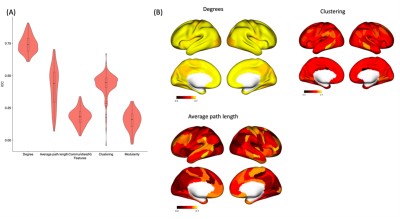 |
19 |
Network representation of fMRI timeseries using visibility
graphs
Govinda Poudel1
1Australian Catholic University, Melbourne, Australia Keywords: Data Analysis, fMRI (resting state) Timeseries can be mapped into graphs by linking visibility of the signal at each time-point with respect to others – an approach known as visibility graph. We used visibility graph analysis to convert fMRI data into complex networks. We then evaluated the graph theoretical properties of this network and characterised their robustness to motion and test-retest reliability between sessions. We show that time-series network features such as average degree, average path length, and clustering coefficient are highly sensitive to motion. However, on a low-motion dataset they have a good reliability between sessions. |
|
2548.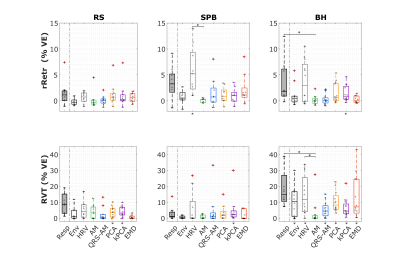 |
20 |
Physiological contributions of ECG-derived respiration to BOLD
fluctuations during resting-state and respiratory modulations
Inês Esteves1,
Ana R. Fouto1,
Amparo Ruiz-Tagle1,
Gina Caetano1,
and Patrícia Figueiredo1
1ISR-Lisboa and Department of Bioengineering, Instituto Superior Técnico – Universidade de Lisboa, Lisbon, Portugal Keywords: fMRI, Multimodal, ECG, respiration Physiological signal acquisition during fMRI may be used for multiple purposes, though it usually requires additional setup which may increase complexity and cause subject discomfort. Since ECG is modulated by respiration, an ECG-derived respiration (EDR) may be obtained without needing extra equipment for EEG-fMRI studies, which inherently use the ECG. In this work, EDR signals were computed for resting-state and two respiratory challenges modulating respiration patterns, to validate their use in the MR environment. Their performance for estimating physiological regressors of BOLD-fMRI signals was similar to the one obtained by using concurrently acquired respiratory signals. |
|
The International Society for Magnetic Resonance in Medicine is accredited by the Accreditation Council for Continuing Medical Education to provide continuing medical education for physicians.